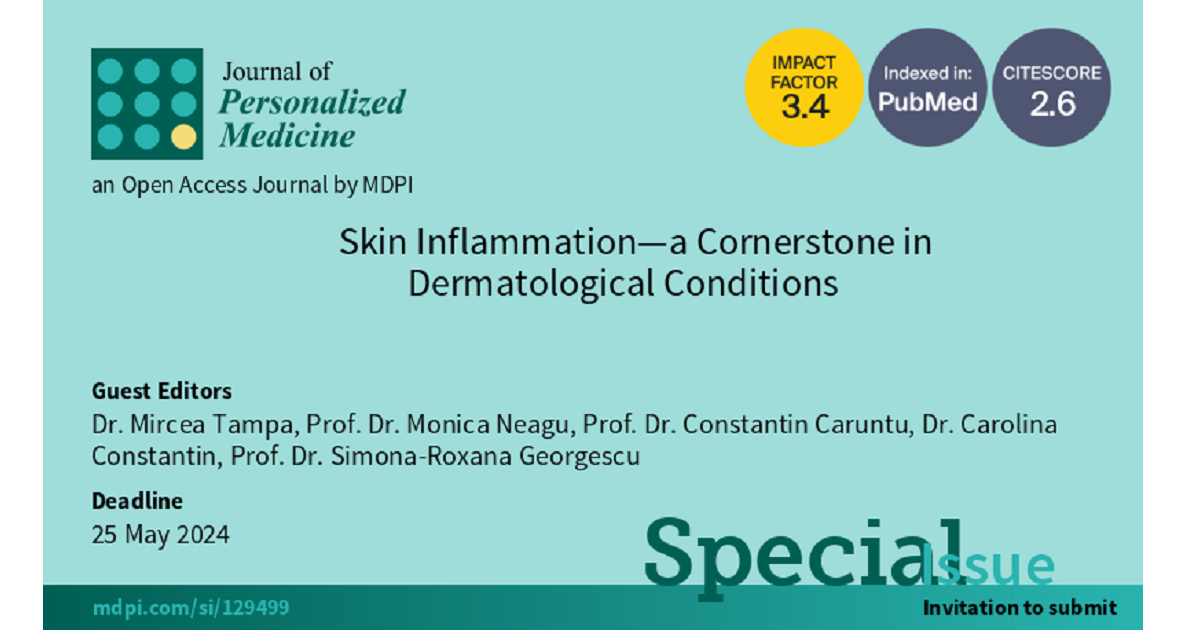Skin Inflammation—a Cornerstone in Dermatological Conditions
A special issue of Journal of Personalized Medicine (ISSN 2075-4426). This special issue belongs to the section "Mechanisms of Diseases".
Deadline for manuscript submissions: 25 May 2024 | Viewed by 18361

Special Issue Editors
2. Department of Dermatology, “Carol Davila” University of Medicine and Pharmacy, 37 Dionisie Lupu Street, 020021 Bucharest, Romania
Interests: dermatology; inflammation; carcinogenesis; oxidative stress
Special Issues, Collections and Topics in MDPI journals
2. Immunology Department, “Victor Babes” National Institute of Pathology, 050096 Bucharest, Romania
Interests: immuno-oncology; biomarkers; inflammation; melanoma
Special Issues, Collections and Topics in MDPI journals
Interests: physiology and physiopathology of the skin and oral mucosa; dermato-oncology; in vivo reflectance confocal microscopy
Special Issues, Collections and Topics in MDPI journals
2. Department of Pathology Colentina University Hospital, 020125 Bucharest, Romania
Interests: immunity; inflammation; nanomedicine; proteomics; skin cancer; biomarkers; epigenome
Special Issues, Collections and Topics in MDPI journals
2. Department of Dermatology, “Victor Babes” Clinical Hospital for Infectious Diseases, 283 Mihai Bravu Street, 030303 Bucharest, Romania
Interests: dermatology; psoriasis; skin infections; skin cancers; viral infections; autoimmune disorders
Special Issues, Collections and Topics in MDPI journals
Special Issue Information
Dear Colleagues,
Inflammation is a major protective response of the human body to exogenous or endogenous aggressors; however, when the process becomes chronic, it can exert harmful effects on cell or tissue components. The skin is a highly specialized organ of the human body that serves a wide range of functions and represents the primary interface between ourselves and our environment. At the same time, the skin is the place for various inflammatory processes that can take various forms, resulting in a wide range of signs and symptoms, and the main players are immune cell populations, keratinocytes and cytokines, which create an inflammatory microenvironment. A growing body of evidence supports the role of inflammation in skin carcinogenesis by increasing the production of reactive oxygen species that can induce DNA damage, a process that, in turn, exacerbates inflammation.
Inflammatory skin diseases are frequently encountered conditions that unfortunately affect a large number of people at all stages of life. Chronic inflammatory skin disorders are a group of heterogeneous afflictions that encompasses numerous diseases that tend to have a significant impact on patients' quality of life. Numerous therapeutic options are currently available, but the results are often disappointing. Personalized therapies may provide a far more tailored treatment to achieve the best outcome for individual patients. Deciphering the intimate mechanisms involved in inflammatory processes contributes to reaching this goal.
The aim of this Special Issue is to explore the recent advances in research involving the causes, diagnosis and treatment of inflammatory skin disorders. Both clinical and basic science studies are to be considered, as we warmly invite researchers to submit original research manuscripts as well as reviews, in order to offer the readers a deeper understanding of these complex disorders and a fresher perspective of the field.
Dr. Mircea Tampa
Prof. Dr. Monica Neagu
Prof. Dr. Constantin Caruntu
Dr. Carolina Constantin
Prof. Dr. Simona-Roxana Georgescu
Guest Editors
Manuscript Submission Information
Manuscripts should be submitted online at www.mdpi.com by registering and logging in to this website. Once you are registered, click here to go to the submission form. Manuscripts can be submitted until the deadline. All submissions that pass pre-check are peer-reviewed. Accepted papers will be published continuously in the journal (as soon as accepted) and will be listed together on the special issue website. Research articles, review articles as well as short communications are invited. For planned papers, a title and short abstract (about 100 words) can be sent to the Editorial Office for announcement on this website.
Submitted manuscripts should not have been published previously, nor be under consideration for publication elsewhere (except conference proceedings papers). All manuscripts are thoroughly refereed through a single-blind peer-review process. A guide for authors and other relevant information for submission of manuscripts is available on the Instructions for Authors page. Journal of Personalized Medicine is an international peer-reviewed open access monthly journal published by MDPI.
Please visit the Instructions for Authors page before submitting a manuscript. The Article Processing Charge (APC) for publication in this open access journal is 2600 CHF (Swiss Francs). Submitted papers should be well formatted and use good English. Authors may use MDPI's English editing service prior to publication or during author revisions.
Keywords
- Chronic inflammation
- Inflammatory skin diseases
- Tumor immunity
- Oxidative stress
- Immune response
- Autoimmunity
- Inflammatory microenvironment
- Biomarkers of inflammation
- Inflammatory signaling pathways
- Psoriasis
- Carcinogenesis










